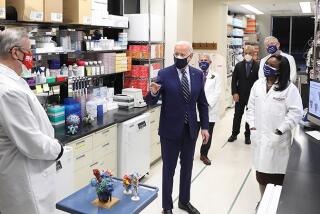Hopes Grow for Generic AIDS Drug : Health: Efforts by the National Institute of Health increase the chances for U.S. and Canadian firms to capture more than half of the market for AZT.
- Share via
More than a year ago, sister drug companies in the United States and Canada first laid plans to enter the health marketplace with a low-cost generic equivalent for the most widely used AIDS drug, AZT.
Now, with the federal government adding weight to their efforts to break the monopoly held by AZT’s manufacturer, Burroughs Wellcome Co., they may get the chance, slicing the cost of the life-extending drug as much as 75% in the process.
Given an opportunity to compete, the firms--Barr Laboratories Inc., based in Pomona, N.Y., and Apotex Inc., of Toronto, Canada, both owned by a Toronto-based holding company, Sherfam Industries Inc.--believe that they could capture more than half the North American market for AZT, also known as zidovudine.
“It could make a potentially dramatic change in access to AZT,” said Phill Wilson, AIDS coordinator for the city of Los Angeles.
The prospect of opening a competitive market for the manufacture and sale of AZT grew on Tuesday, when the National Institutes of Health declared that government scientists helped to develop the antiviral drug and should be able to license companies other than Burroughs to manufacture it.
That effectively aligned the federal government with Barr Laboratories in a lawsuit challenging Burroughs’ patent for AZT. Public Citizen, a public-interest group, has also filed a lawsuit on behalf of AIDS patients against Burroughs and the government challenging the patent.
AIDS activists and members of Congress have long been critical of Burroughs’ pricing of AZT, the only licensed antiviral drug for combating the complications of AIDS and the only drug routinely prescribed for AIDS patients. When introduced four years ago, the drug cost patients as much as $12,000 a year. After several price cuts, the cost to the average patient now is $3,000 annually.
But if the patent contests are successful, other companies are expected to follow Barr and Apotex into a marketplace that has grown, inexorably, with the spread of the AIDS virus.
“In other parts of the world, where there is more competition, the price has dropped to pennies a dose,” said Mark Vandervelden, director of government affairs for the AIDS Healthcare Foundation in Hollywood.
In the United States, current estimates are that 500,000 persons at an early stage of the disease--those infected with the AIDS virus who have T-cell counts of 500 or below--would benefit from AZT. Many of those individuals, however, do not know they are infected and are not seeking treatment.
The drug is also prescribed for the estimated 100,000 patients showing active symptoms of acquired immune deficiency syndrome.
Barr Laboratories has already asked the federal Food and Drug Administration for permission to manufacture a generic equivalent of AZT in the United States. If it wins its patent fight, under U.S. law it will receive exclusive rights for 180 days before other firms could make the generic drug, said Barry Sherman, the firm’s chairman.
Apotex has launched a parallel effort in Canada to receive manufacturing permission from the Canadian equivalent of the FDA.
Sherman hopes to end up with at least half the market in the United States and more than half in Canada.
“Public institutions and governments will buy the lowest priced product,” Sherman said. Under Canada’s national health-care program, provincial governments make the purchasing decisions, he noted. And in the United States, 40% of AIDS patients ultimately become Medicaid beneficiaries.
A generic AZT “would immediately become Barr’s No. 1 product” and Apotex’s second-biggest, Sherman said. Apotex, the largest Canadian-owned pharmaceutical firm, had sales of roughly $200 million last year. Barr Laboratories had sales of more than $70 million in 1990.
Barr Laboratories, whose stock is publicly traded on the American Exchange, closed Wednesday at $17.25, up 25 cents.
Burroughs Wellcome said it was confident its patent rights would stand up to the court challenges.
“We feel the correct inventors are on the patents as they are, basically because it was scientists at Burroughs Wellcome . . . who first thought of the use of the compound for the treatment,” said Kathy S. Bartlett, a spokesperson for the company, based in Research Triangle Park, N.C. The U.S. firm is a wholly owned subsidiary of Wellcome Foundation Ltd. of London, England.
AZT accounted for $150 million of Burroughs’ $1.4 billion in worldwide sales in the first six months of 1991, second only to Zovirax, a herpes medication, with $400 million in sales. Burroughs manufactures 90 different drugs.
U.S. Rep. Henry A. Waxman (D-Los Angeles), who has actively supported an opening of AZT manufacturing to other companies, expressed hope Wednesday that the NIH’s actions would lower AZT prices and begin to change the way government money is used in drug research.
“There’s too little money for us to spend tax dollars to train researchers, develop drugs, and then hand them over to someone else to make profits, and price the drugs out of reach of sick people,” he said.
But Vandervelden, of the AIDS Healthcare Foundation, said there could be a backlash from the federal government’s stance: Pharmaceutical companies could be deterred from pursuing research and development if they cannot control the fate of their drugs or recover their costs.
Wilson, the Los Angeles city AIDS official, said the high cost of AZT continues to harm people infected with the AIDS virus. A state subsidy for AZT purchases ran out in April, meaning that clinics which treat poor patients either have had to limit supplies or go over their budgets to provide the drug.
“It seems unreasonable for Burroughs Wellcome to be getting the kind of return it has been getting, since the government helped develop the drug,” he said.
AIDS in the U.S. Figures show the number of cases of acquired immune deficiency syndrome diagnosed in the United States through December, 1990. Source: HIV / AIDS Surveillance Report
Potential AZT market An estimated 1 million people are now infected with AIDS. Fully 60% could benefit from AZT,though many are unaware they have the disease. Infected but in dormat stage: 40% Have full-blown AIDS and need AZT: 10% Infected and could benefit from AZT if they seek medical attention: 50% Source: Centers for Disease Control






